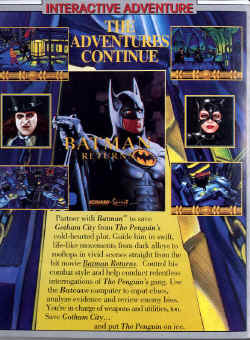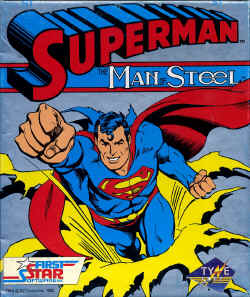An Answered Prayer, Part II From Dream Project to Dark Knight-mare, As Told in Two Parts
By Bill Kunkel PART ONE: THE REALITY If you missed Part I of this story, start here! The day a copy of the script for "Batman Returns" arrived via Federal Express offered me a remarkable spectrum of emotion. First came the pride; I was getting an advance peak at one of the hottest properties in Hollywood. Then the sense of cool, of being connected to Tim Burton and all that incredible dark winter imagery I had toured back at the Warner Bros. Studio backlot. Then came the shattering gong of Reality. But I get ahead of myself…  After the script was delivered, I adjourned first to my bedroom, lit up a smoke, and sat back to peruse the written word and contemplate how I would handle its revolutionary transition to the interactive world. Arnie Katz, Joyce Worley and I had already discussed a general approach to the game design which would run completely counter to the platform-based videogame and handheld versions we expected to glut the market. After the script was delivered, I adjourned first to my bedroom, lit up a smoke, and sat back to peruse the written word and contemplate how I would handle its revolutionary transition to the interactive world. Arnie Katz, Joyce Worley and I had already discussed a general approach to the game design which would run completely counter to the platform-based videogame and handheld versions we expected to glut the market.
At the time, PCs were not really the ideal platform on which to build a twitch game anyway, so we went in different directions. Batman, for example, could return to the Batcave in between trips to Gotham City, where he could select weapons and other tools to stick in his utility belt (a limited number of slots would keep the player from bringing the entire cave with them on each mission). During the mission, the player could simply click on any of these items and they would automatically be brought into play. We even had a different design idea for the inevitable fight sequences. The plan was to give players a sort of gauge which would allow them to control how hard our superhero fought. This would allow Batman to engage in combat at any level from merely parrying blows to battling full out. Of course, Batman is human, and he can only fight full out for so long. The intention was that players would have to constantly reorient Batman's fighting level based on the immediate threat and the object of the mission. Park Place had been tremendously cooperative in the early stages and agreed to develop an engine which would position Batman in a typical visual pose at the start of each mission (a rooftop, a church steeple, etc.). From there, using a smart cursor, the player would be able to click on any of numerous available locations and Batman would immediately animate and head for that position as expediently as possible. It all seemed quite wonderful and fascinating. And then I read the script. How can I describe the Lovecraftian sense of horror that engulfed me as I turned the pages of that wretched sceenplay? Does it suffice to confess that by the time I reached the scene in which an army of Emperor Penguins launch surface-to-air missiles off their backs that I was weeping openly? Had I merely been the Batman fan of old, this travesty would have boiled my blood. Now, I was a part of the disgrace. I would be a ringleader in the betrayal of my childhood hero. I would design the damn game in order to collect the milestone payments and then I would probably throw myself out a window. The next few months comprised one of the worst periods of my life. The pressure of designing a state-of-the-art game began to affect my health and I nearly wound up in the hospital, but the design trudged on. In those days, it was not uncommon for designers to be removed from the loop the instant the document was created. That really sucks, since you don't get to see if your ideas worked until a shrink-wrapped copy of the game arrives.  It is, however, occasionally preferable to receiving feedback. Park Place was doing its best, but the company was in serious trouble. It had expanded far too quickly and attempted to create its own imprint, "Spirit of Discovery" under Konami's banner. The experiment was a financial disaster. Then the five or so different publishers who had signed licenses with Park Place to produce football games under the impression that each of them was getting the only football game showed up at CES and saw a whole lot of Park Place gridiron simulations. It is, however, occasionally preferable to receiving feedback. Park Place was doing its best, but the company was in serious trouble. It had expanded far too quickly and attempted to create its own imprint, "Spirit of Discovery" under Konami's banner. The experiment was a financial disaster. Then the five or so different publishers who had signed licenses with Park Place to produce football games under the impression that each of them was getting the only football game showed up at CES and saw a whole lot of Park Place gridiron simulations.
So, with the designer sick, the developer in trouble and Konami preparing for ritual suicide, an even worse thing happened – Warner Bros. decided to make ITS "creative contribution" to our accursed project. The game, these Hollywood hacks declared, should contain exclusively scenes from the film. They were especially keen on having a recreation of the "spinning Batmobile" scene added to the game. If you don't remember the spinning Batmobile, don't feel badly. It's not exactly up there with the final moments of "Casablanca", the Potempkin Steps sequence or the backseat scene between Rod Steiger and Marlon Brando in "On the Waterfront". Batman gets into his trademarked vehicle, but finds he is no longer in control of his creation. The Penguin's minions have monkeyed with it, causing the car to rise up on a massive cylinder and go into a heavy duty spin-dry cycle, with the object being to shake its driver to death. Batman's a thinker, right? Cool under pressure, no? So how does he solve this problem while spinning like a nuclear top? Why he punches a hole in the floorboard and yanks loose a couple of wires, causing the car to slow to a stop. Big whoop. The more maddening problem was how exactly to transfer such a sequence into computer game terms. Even if Park Place could generate the first-person spindizzy effect, it wouldn't make the player dizzy, so that meant resorting to some sort of artificial device, like a countdown clock. The more substantial problem was the scenario's solution. Anyone who saw the movie, would know they were "supposed" to punch through the floorboard, thereby eliminating any hope of making this a problem-solving element (it's a GAME, remember?). Worse, there was nothing in our game engine that would have allowed the player to select such an option.  God alone knows how we eventually solved the problem, or even if we solved it, Maybe Warners eventually stopped giving a shit, since it was pretty clear from the "updated" versions of the game that I infrequently received that there wasn't a lot happening with the game at Park Place. God alone knows how we eventually solved the problem, or even if we solved it, Maybe Warners eventually stopped giving a shit, since it was pretty clear from the "updated" versions of the game that I infrequently received that there wasn't a lot happening with the game at Park Place.
They were too busy trying to make five different football simulations seem significantly different. Of course the programmers and artists did eventually manage to fill up no fewer than seven 3.5" floppy disks, but by then it was too late. I received a finished copy of the game months after the movie was released to uniform disappointment (it was to be the last time either Burton or miscast star Michael Keaton would be permitted near the franchise). I even tried to play it. Once. And then I put the disks back in the box and stuck the game on my shelf and walked away from the entire mess. As time went on and I would periodically compile lists of games I had worked on and would occasionally mention "Batman Returns" from Konami among my "credits". And I felt some shame when they would tell me how much they enjoyed it because I knew they were talking about the Genesis or SNES platform SKUs. But I never corrected them. After all, I had gotten an answer to my prayer. It isn't my fault that the answer was a cosmic belly laugh. |

